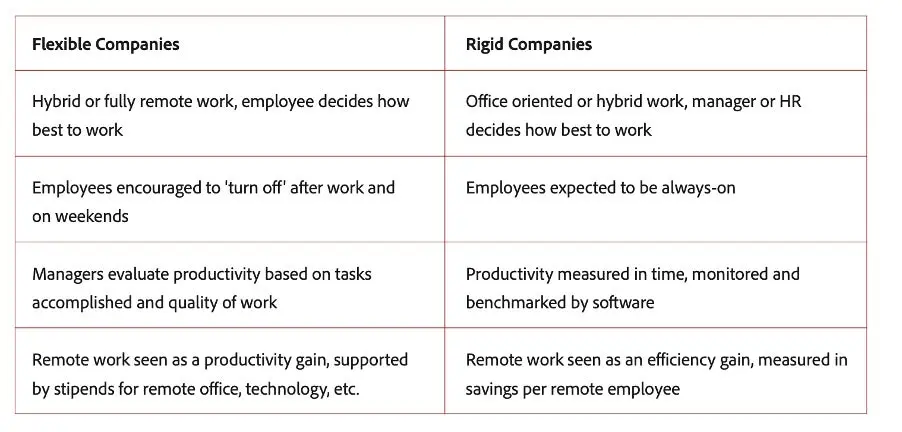How ANZ organisations can prepare for — and help shape — the future of work

Adobe VP Suzanne Steele shares how organisations in ANZ can help shape the future of work through flexible models, leadership and investment in future talent.
It’s widely recognised that the events of 2020 – and now 2021 – turbocharged digital transformation for businesses around the world. However, the Adobe 2021 Digital Trends report goes beyond to explore how the global pandemic rewrote the economic rulebook. To briefly summarise, the report found:
Flexible businesses ahead of the digital transformation curve are enjoying above-average long-term growth and are demonstrating a greater capacity to respond effectively to unexpected events than their more rigid competitors.
Business leaders across the globe believe digital transformation, especially the type that helps companies deliver a better customer experience (CX), is critical to maintaining a competitive advantage.
There’s now near-universal agreement that businesses need to use technology to provide customers with more frictionless and personalised experiences.
Business leaders reported that their desire to provide a better digital experience to their customers is typically impeded by three constraints: (1) workflow (the collection of methods used to arrange workplace processes), (2) legacy systems, and (3) a lack of digital skills.
Contents
Moving from rigid to flexible.
Overcoming the first two of the barriers mentioned above isn’t easy. But it is relatively straightforward for change managers willing to invest in the type of cloud-based solutions Adobe provides. Addressing the third is much tricker, especially for business leaders in Australia and New Zealand.
Arguably the most significant observation in the 2021 Digital Trends report is this one: “Companies will unconsciously sort themselves into two categories: rigid and flexible. In the battle for the best digital and CX talent, flexibility will win in a landslide.” The table below summarises some of the key differences:
In Australia and New Zealand, most business leaders are motivated and open to being more flexible to win the battle for the best digital and CX talent. However, there are plenty of executives who are unsure about how to best go about doing that.
I’ve observed Adobe transforming itself from a ‘rigid’ seller of perpetual-licence desktop software with an arms-length relationship with its customers to a ‘flexible’ provider of subscription-based solutions that interacts with its customers 24/7. Based on my experiences, I’d like to offer three pieces of advice to business leaders in the region who want to attract, retain, and develop the talent they need to digitally transform their businesses.
When the economy changes, you need to change your leadership style.
I’ve long believed it’s vitally important to lead with empathy and foster creativity in the digital age. Leaders must have a relentless focus on people, process, and technology to create the kind of flexibility that empowers employees and customers.
With the exponential growth of technology and automation, creativity has become a core driver and differentiator for businesses. COVID-19 has forced organisations to operate in new ways. More than ever, creative skills such as insight, collaboration, and ideation are critical for success.
The greatest area of opportunity for business leaders in ANZ is better fostering and leveraging the creative skills of their team members. While true of business leaders across the globe, evidence suggests that executives in this part of the world are dragging the chain. The 2020 results from Adobe’s CQ (creativity quotient) assessment show that 22 percent of leaders in ANZ excel in helping their teams develop creative skills like critical thinking, problem solving, and collaboration.
Business leaders need to support employees to step out of their comfort zones and challenge their assumptions if they are to make space for creative insights to emerge.
By embedding creativity into behaviours, ideas and processes, leaders can tap into the creative potential of individuals and the collective intelligence of their teams. This empowers people to seize new opportunities and take informed risks that drive themselves and the business forward.
One thing I’ve always appreciated about Adobe is that it’s a true meritocracy — one where people at every level are regularly encouraged to volunteer ideas and where great ideas are recognised and rewarded regardless of where the originator sits in the org chart.
If you want access to tech talent, you’ll have to participate in upskilling those already in the workforce and educating those who will soon enter it.
Businesses in Australia and New Zealand have long had the luxury of importing workers with the technological skills they require. Even when skilled migration programs return to some semblance of normal functioning, there simply won’t be enough tech-savvy workers to go around in the years to come — especially since employers in ANZ will be competing ever more ferociously for digitally skilled workers with their counterparts in the UK, the US, Canada, and Singapore.
The digital future of ANZ relies on developing the next generation of technologically literate workers, taking action to close the widening gap between talent supply and demand, and future-proofing the skill sets of those already in the workforce.
The Australian Government’s $1.2 billion Digital Economy Strategy highlighted the need to reskill and upskill Australians. New Zealand’s Ministry of Business, Innovation and Employment is similarly focused on “maintaining and growing the digital skills of New Zealanders… so that our economy and social prosperity can continue to grow.”
Business leaders will have to make their own decisions about how to upskill their current employees and contribute to the education of potential future employees. The following Adobe programs and policies could provide some helpful inspiration:
External education opportunities – Adobe staff can pursue a graduate degree funded through the Adobe benefits program.
Internal management-training programs – Adobe staff who are already managers — or aspire to be — can partake in programs such as Leadership Circles and the Women’s Executive Shadow Program.
Funding for aspiring tech-industry employees – Changing careers is generally expensive and risky. This is one of the reasons many capable individuals with an interest in technology remain stuck in sunset industries.
Since 2016, such individuals have had the option of applying to the Adobe Digital Academy. If successful, they receive a scholarship to attend an intensive three-month web development boot camp at General Assembly. Additionally, to help other companies build their own apprenticeship programs, Adobe has created an open-source playbook explaining our process and offers tips and best practices.
In Australia, Adobe has partnered with the Federal Government and some of the world’s leading technology companies to launch Skill Finder. Skill Finder offers free courses aligning with in-demand skills such as coding, cloud computing, data science, project management and software development.
Encouragement for tech-industry employees of the future – Adobe has given $3.5 million to Australian youth coding initiatives, such as Girls Who Code.
Mentoring opportunities – My first mentor was a business leader at a start-up. He recognised my untapped potential and used his coaching skills to help me grow into a leadership role. He let me fail and taught me how to learn from those failures. As my career progressed, several other mentors played a pivotal role in shaping my career path. So, I know from personal experience that there are some things you’ll never be able to learn on a training course — an insight that’s supported by lots of empirical evidence.
Similar to how frontline managers need advice from department heads, department heads need advice from executives, and executives need advice from CEOs – those early in their career need pointers from their more experienced peers.
At Adobe, I’ve helped to establish the Australian branch of the Adobe & Women Employee Network. This program offers mentorship, networking opportunities, and career development programs to female employees. I’m also one of Adobe’s ‘150 Global Executive Champions,’ which means I devote significant time and effort to developing the leadership qualities of senior Adobe staff.
If you want to digitally transform your business, first get serious about its commitment to diversity.
For all kinds of reasons, people interested in technology tend to like working for businesses that champion and, ideally, embody diversity. Of course, today, it’s rare to see a company that doesn’t claim to be committed to diversity, but people are smart enough to work out whether a business is walking the walk or just talking the talk.
As a woman promoted to senior roles in technology businesses back when that was still relatively unusual, I’ve long been passionate about helping others realise their full potential, regardless of their background, life experiences, and perspectives. I’m encouraged by all the progress that’s been made since I entered the workforce, but I would like to see workplaces become even more diverse and inclusive.
The Adobe For All vision for inclusion acknowledges all the ways Adobe staff are different, including race, ethnicity, age, disability, sexual orientation, gender identity, cultural background, religious beliefs, and everything else that makes us who we are. The Adobe For All vision goes beyond expressing fine sentiments — it rewards leaders who take concrete action to eliminate conscious and unconscious bias from hiring, remuneration, and promotion processes.
For instance, Adobe has long been dedicated to pay parity and ensures employees in the same job and location are paid the same, regardless of their gender or ethnicity. In this part of the world, I’m now championing ‘opportunity parity’ in the hopes that it will eventually become an industry benchmark.
Opportunity parity means that all Abode employees have an equal opportunity to be promoted, or should they wish, make a sideways move into a different role. Undoubtedly, there’s still some way to go until Adobe achieves full opportunity parity. But the fact that promotion rates for female and male Adobe employees in the Asia-Pacific region now sit at 16 percent and 15.6 percent respectively suggests that gender bias has now been eliminated.
The best way to create a rosy future is to play a part in engineering it.
If events such as the global financial crisis and the rapid spread of COVID-19 across the world proved anything, it’s that we all exist within a protean global economy. And businesses that are capable of responding quickly to threats and opportunities have an enormous competitive advantage.
Adobe supplies the technology that allows business leaders to build flexible organisations and deliver digital experiences that matter to their customers. However, to get the total value from their investments in technology, leaders also need to make significant investments in talent.
If you want your business to prosper as the Fourth Industrial Revolution unfolds, you need to invest heavily in training future talent and accelerating the development of your current employees. You’ll also need to forge a 21st-century workplace where all staff are encouraged to realise their full potential — and where those in management roles are expected to act as empathetic coaches rather than command-and-control foremen.
Source : Adobe









